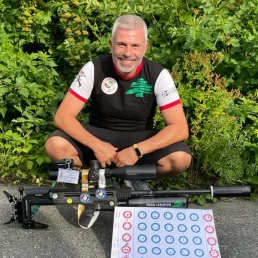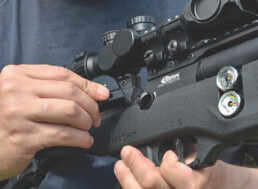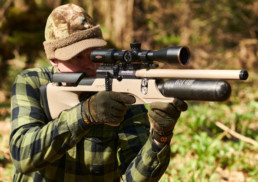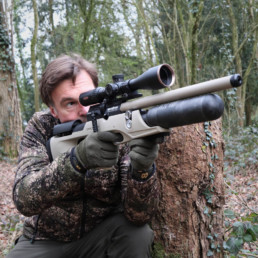NEW BRK Silencers

New for 2023, BRK’s MF 1/2" UNF Silencers. The quietest silencer BRK has ever made eclipsing the performance of many existing and more expensive custom brands.
The MF170mm is the long version designed for ultimate silencing and use on shorter rifles such as bull-pup designs and carbines, while the MF 121 is the short, intended to compliment longer full-length rifles. Both silencers have 40mm diameters, which makes them super effective in cutting down muzzle noise. Fits industry standard 1/2″ UNF threads. Calibre specific to .177 (4.5mm) and .22” (5.5mm) Calibre.
It is the perfect accessory for any airgun shooter wishing to make as little muzzle noise as possible.
| MF121 | MF170 | |
|---|---|---|
| Weight | 151g (5.32oz) | 195g (6.87oz) |
| Length | 121.78mm (4.79”) | 170mm (6.69”) |
| Diameter | 40mm (1.57” | 40mm (1.57” |
| Sutability | Airgun Only | Airgun Only |
| Fitment | ½” UNF | ½” UNF |
| Calibre | .177 (4.5mm) and .22” (5.5mm) | .177 (4.5mm) and .22” (5.5mm) |
| SRP (UK) | £110.00 | £115.00 |
Two new super-efficient silencers from BRK, the MF170mm Long and the MF 121mm Short.
Summer Break 12th-21st Aug

BRK WILL BE TAKING A SUMMER BREAK FOR JUST ONE WEEK – STARTING 12TH AUGUST, AND WE WILL BE BACK AT WORK ON MONDAY 21STAUGUST.
Shooting to Victory
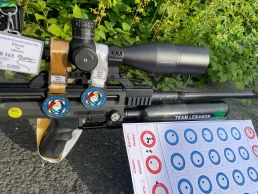
World WRABF Champion and a World Record
BRK Team Shooter, Fady Kiwan has dominated the Benchrest Rimfire and Air Rifle World Championships held in Plzen, Czech Republic, winning two world titles and setting a record score with his BRK Ghost Air Rifle.
The competition, which is sanctioned by the World Rimfire and Air Rifle Benchrest Federation (WRABF) and European Rimfire & Air Rifle Benchrest Shooting Federation (ERABS) saw 237 competitors from 23 countries take part in a range of events between July 26 and August 4.
Fady competed in the Light Varmint 25 metres, Heavy Varmint 25 metres and Unlimited at 50 metres categories. Unlike most other shooters who used highly specialised custom rifles, Fadyused a standard BRK Ghost, only swapping between 17” and 28” barrels and .177 and .22 calibres – a process that takes just a few minutes.
A score of 725.21 points was not only good enough to win the 50m Unlimited world title but set a new record of 247/250 in the process. In addition, he went on to be crowned World Champion in the Three Gun category from his total scores in Light Varmint, Heavy Varmint and 50m unlimited all with the same Ghost.
Put it in your pack

Dave Barham reveals an exciting new compact hunting rifle from BRK Brocock
Launched at this year's Northern Shooting Show, the BRK Brocock Pathfinder XR is another one of those rifles that is going to sell like hot cakes! There aren't many compact, lightweight hunting rifle, especially ones that fold up small enough to put in a small rucksack.
THE LONG AND SHORT OF IT There’s always a lot of folk spreading misinformation that this style of rifle isn’t legal. Do you really think that a company as big as BRK Brocock would produce a rifle that wasn’t UK legal? Here is an excerpt from a statement issued by Brocock on the matter; ‘Brocock confirms that the Brocock Pathfinder XR conforms with the UK Firearms Act 1968 in that it is an air weapon and is exempt from defining gun length as specified under Section 5 ( 1) (aba). ‘Brocock further defines the Brocock Pathfinder XR as an Air Rifle, which does not exceed a muzzle energy of 12 foot pounds and
Mat Manning on the BRK Ghost
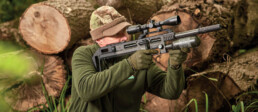
In his first role as the new Editor of the prestigious AIR GUNNER magazine, Mat Manning does a complete and in-depth review of the new BRK Ghost.
The new BRK Ghost has a haunting name and paranormal power potential – and it certainly raised editor Mat Manning's spirits when he put it through its paces.
Airgun development seems to move faster and faster as the years go by, and the gunmakers who embrace change rather than resist it tend to be the ones who come out on top. Brocock is a brand that most definitely isn’t adverse to progress and adaptation, and to emphasise that point the British gunmaker recently announced its decision to rebrand to BRK, on the same day that it unveiled its latest airgun offering – the subject of this review – to assembled shooting journalists on a press day at Oakedge Shooting Ground in Staffordshire.
The BRK Ghost is the fi first launch under the brand’s snappy new moniker and is a fi fitting way to mark the business’ next chapter.
A highly versatile and adaptable bullpup with variants to cover most airgun shooting scenarios, it sits very comfortably with current tastes for airgun design, whilst accommodating the degree of tuneability that more and more shooters are demanding as airgun and ammo technology progresses.
FUNCTIONAL FRAME
While the Ghost is a brand-new airgun in its own right, anyone familiar with BRK’s sister company, Daystate, will recognise the frame of the Delta Wolf and Alpha Wolf electronic superguns. The synergy between the two brands enables some terrifi c gains through shared research and development, and
the Ghost benefi ts from the
super-rigid, one-piece chassis that was developed for the flagship Daystate’s, whilst running a fuss-free mechanical action.
The stock has certainly been built more for function than form, yet the overall look remains very kind on the eye – especially in the stubby Carbine option featured here, which is just
a touch over 65cm long without a silencer fitted, has a 43cm barrel and tips the scales at 3kg. This model is equipped with a 300cc carbon air bottle, whereas the longer Plus and High Power versions both feature 480cc carbon bottles; the former has a barrel the same length as that on the Carbine, but with a longer shroud, and the latter has a 60cm barrel and can churn out muzzle energy in excess of 100 ft.lbs.
SERIOUS MONEY
Prices start at £1,440 for the Carbine, moving up to £1,500 for the Plus and £1,600 for the High Power. That is serious money but still compares very well with the Ghost’s contemporaries when you take its features, performance and build quality into account.
Starting at the rear of the titanium-coloured stock, the Ghost has a height-adjustable butt pad of simple yet effective design. In front of that sits a cheek support with a curved edge, which makes for a comfortable contact point. The support actually sits on a dovetail rail and you can slacken off its fastening screws and slide it back and forth to achieve correct positioning. That rail actually extends the entire length of the top section of the stock and also holds the Picatinny scope rail, which can be adjusted in the same way to ensure perfect eye relief whichever type of optic you choose to use. BRK has cleverly incorporated a tiny degree of slope into the rail, which should do away with the need to shim mounts when zeroing scopes at extreme range.
HUGE POTENTIAL
The stock incorporates two side rails for accessory attachment and an underside rail for bipod mounting, plus a very nice pistol grip. Contoured in a way that cradled my hand very well, the grip is steeply angled and delivers good trigger attack. Like the butt pad, it can be swapped out for different designs and the range of PRS accessories already available for the previously mentioned Daystate models result in huge potential for customising the Ghost.
Although simplistic, the ambidextrous stock has been carefully designed to function as an effective handle. As with many airguns of its kind, the carbon bottle serves as the fore-end, and even with the small bottle on the Carbine, it provides sufficient room for most holds. I did have to be mindful about keeping my fingers away from the muzzle, which only just clears the bottle – the best solution to that was to fit a 0dB silencer via the thread at the front of the carbon shroud. Apart from really suiting the gun’s styling, the silencer also muted the sub-12 ft.lbs. Ghost’s muzzle report to a whisper.
FULL-ON FEATURES
The Ghost is absolutely rammed with features, and one of the most interesting has to be its huge potential for power adjustment. All models run Huma regulators, and reg pressure – displayed on a gauge on the left-hand side of the stock – can be adjusted by the turn of a knob above the neck of the bottle on FAC models.
Legal restrictions prevent such adjustment on sub-12 versions, but all models feature a power wheel just in front of the top part of the butt pad. This dial tweaks hammer spring tension with no less than 20 settings – that is a lot more tool-free adjustment than most of us are used to on legal limit airguns, and combined with the reg’ adjuster, will facilitate a huge amount of fettling on the high-power variants.
There is another clever trick up the Ghost’s sleeve in the shape of an easily removable barrel, which enables you to swap quickly between calibres. The barrel is held securely in place by an Allen screw at its rear – slacken that off and it pulls straight out. With the barrel out, you then need to swap the pellet probe, which is fastened by an Allen screw accessed via a hole in the side of the breech, for one that corresponds with the calibre of the barrel you are changing to; replace with the correct probe, tighten the screw, slide the barrel back in, tighten its retaining screw and you’re good to go. Expect the whole process to take around five minutes once you are familiar with it.
SELF-INDEXING MAG’
Slick side lever cocking, with a chunky drop-down handle positioned just above the pistol grip, runs a very reliable magazine which holds 13 shots in .177 calibre, 11 in .22,
10 in .25 and eight in .30. Like the Alpha and Delta Wolf, it also features a magnetic ‘double-up’ system, enabling you to load two magazines at once and shunt the loaded one across when the first one runs empty.
The magazine is a gate-loading, self-indexing model. To load it, you simply flip open the gate and turn the interior drum clockwise until it stops. Drop a pellet nose-first into the bottom chamber to hold it under spring tension, and then it’s just a matter of popping pellets into the remaining chambers. When it’s fully loaded, snap the gate back over, and it’s held in place by a magnet, ready for you to push the magazine back into its slot beneath the cheek support and get on with the shooting. The pellet-friendly magazine and positive sidelever mechanism, which can be swapped over for left-handers, work brilliantly together for fast and reliable reloading.
The article continues… to see the full review subscribe
to the digital or print edition of Air Gunner magazine – the home of airgun shooting!
Kicking up a Sandstorm

The proven Brocock XR range has been given a makeover in the form of the Sahara edition, and Mat Manning reckons there’s much more to it than eye-catching aesthetics
There is a great appetite for airguns that stand out from the crowd, and Brocock airguns usually meet that demand in their own way. The subject of this review goes a step further though, taking the proven reliability of the Sniper XR action and dressing it up in an eye-catching package.
The light sand finish is of course the standout feature of the £1,244 Sahara XR. It may not be to everyone’s taste(and it isn’t meant to be), but even as a shooter who rates traditional aesthetics very highly, I have to concede that the new twist does make for a nice-looking airgun. The pale shades may not be ideally suited to much of the British countryside, but they do look neat on the range.
Airgun Brocock Sahara XR Review

The first thing you'll notice about the new Brocock Sniper Sahara XR is that 'distinctive' sand-coloured finish.
The first thing you’ll notice about the new Brocock Sniper Sahara XR is that ‘distinctive’ sand-coloured finish. That’s perfectly natural, raised as we are in a sporting world where blued and blacked metalwork sits within traditional timber, or its laminated variant, or even the increasingly accepted black synthetic stocks. The Sahara’s lighter than-normal presentation can certainly jar an has covered that by offering the Sniper XR in no fewer than six guises, including the more soothing combinations of wood, synthetic and dark metal.
So why the sand finish7 Mainly because Brocock supplies a healthy overseas market, which includes countries where hunting in desert regions is as normal as our own adventures in this mainly green and pleasant land. Besides, Brocock has already offered this colour scheme on its Sniper HR Magnum high-power version, so the shock of this new treatment should be survivable for most of us.
Mat Manning on the Brocock Sahara XR
“The Brocock Sahara XR is an airgun with looks that will turn heads on the range but also boasts the performance to cut it in the field,” Mat Manning, fieldsports journalist.
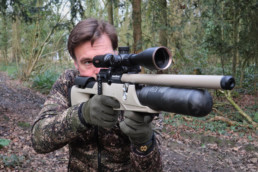
“If you want a reliable and accurate airgun that also stands out from the crowd, the Brocock Sahara XR should fit the bill perfectly,” Mat Manning, airgun journalist.

“Accuracy, power, reliable performance and head-turning aesthetics make the Brocock Sahara XR a very desirable airgun,” Mat Manning, fieldsports journalist.

Mat Manning on the Brocock Safari XR
“The Brocock Safari XR is a fantastic performer, producing remarkably high power levels while still delivering a very refined shooting experience,”

“Apart from being a handsome airgun, the Brocock Safari XR is also a very impressive performer in the power and accuracy stakes. It’s a great choice for long-range pest control,” Mat Manning, field sports journalist.
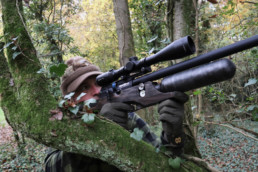
“Despite its remarkable power capabilities, the Brocock Safari XR is a smooth, accurate shooting machine – add a 0dB silencer, and it’s also very quiet,”
Mat Manning, fieldsports journalist.

“There is no questioning the Brocock Safari XR’s capabilities in the power and accuracy stakes but it is also a very handsome airgun, which instils a real pride of ownership. It certainly looks and feels very at home in the field,”
Mat Manning, field sports journalist.

“The combination of high power output, a very smooth multi-shot sidelever action and impressive downrange accuracy, not to mention robust build quality that can withstand proper field use, makes the Brocock Safari XR a great choice for serious pest control,”
Mat Manning, fieldsports journalist.

“Shooters looking for a high-power airgun that combines refinement and accuracy with rugged build quality and reliable performance would do very well to give the Brocock Safari XR a try. It is a remarkable airgun,”
Mat Manning, field sports journalist.
REGULATED vs UNREGULATED
REGULATED vs UNREGULATED Precharged Pneumatic Air Rifles
What is the difference between a regulated PCP and an unregulated?
Precharged pneumatic (PCP) air rifles are powered by compressed air contained in either an integral air cylinder or buddy-bottle. Although the PCP is the serious airgun shooter’s choice, its concept is inherently simple: a hammer strikes a valve that releases some air to thrust the pellet out of the barrel. The hammer always strikes with the same force, so the amount of air released by the opening valve changes as the rifle’s onboard air pressure behind it drops. This affects the velocity (power) output of the rifle as it progresses through its air charge, resulting in what’s known as a power curve.
The specific shape of the power curve varies according to the rifle’s design. Generally, an unregulated PCP’s power output will rise to a peak before dropping off to the point it needs recharging. A power output that’s dependent on the air rifle’s pressure is not ideal because the pellet’s downrange point of impact (POI) will alter accordingly. Because of this, many airgun makers incorporate an air regulator into their guns. In a ‘regged’ PCP, the power output stays consistent throughout its entire air charge.

So, which to choose? Although a regged PCP may seem the ideal, unregged PCPs have been around for many years and are still popular. Indeed, much R&D has been undertaken in the PCP world, so the simple ‘knock-open’ valve of old is a far cry from what we see on today’s airgun hardware. The Slingshot hammer/valve set-up used in some unregulated Brocock and Daystate PCPs is one such example of how far unregged PCP design has evolved. Nevertheless, characteristics of unregged and regged systems are an important consideration when choosing a PCP for your specific shooting needs.
UNREGGED PCP
Between the first and last shots of an unregged PCP’s charge of air – its ‘usable’ range – the output will follow a power curve, peaking somewhere around the mid-point of the curve. While the duration of the peak depends solely on the rifle’s inherent design, this part of the curve is referred to as the ‘sweet spot’. It’s where the shot-to-shot consistency – and so the rifle’s accuracy – will be at its best. The longer the sweet spot, the better. Ideally, that is where you want to be doing most of your shooting (and where you should zero your scope).
Of course, you can shoot either side of the sweet spot, but you may well see a slight change in the pellets’ POI. At relatively close ranges this probably isn’t a problem, but it may shift your pellets outside acceptable limits for hunting or competitive target shooting at longer distances. Therefore, with any unregulated PCP, it pays to familiarise yourself with the characteristics of its power curve so that you can compensate for POI shift if required.
Although an unregged PCP lets you shoot throughout its usable pressure range (200 down to 100 BAR in this example), the best consistency, power and accuracy will be obtained by shooting in its ‘sweet spot’ (165 down to 120 BAR in this example)
For example, your rifle may fill to 200 BAR and then, 150 shots later, need a refill at 100 BAR. Let’s assume its sweet spot spans 65 of those 150 shots. Then it would be worth noting on the rifle’s manometer what pressure range relates to that 65-shot section – perhaps between 165 and 120 BAR. If the number of shots you get per charge of air doesn’t bother you, you could choose to fill the rifle only to 165 BAR each time, and always refill it at 120 BAR. Yes, the trade-off is that you’d be reducing the rifle’s shot count, but in return, you’d be getting an output performance on a par with a regged PCP. Plus, by starting at lower pressures, charging the rifle from a manual pump will be less effort, and you’ll get longer periods between scuba tank fill-ups.
REGGED PCP
Where an air regulator is fitted to a PCP, air release is far more controlled for the entirety of the rifle’s charge and there is, therefore, no power curve. Effectively, a regged PCP offers a sweet spot that extends from the first to the last shots of the usable shot range. In some cases, because a regulator deals with air delivery more efficiently, the rifle also returns more shots between fill-ups.
Generally, a regulator system incorporates a secondary air chamber (the plenum chamber) which is designed to operate at a constant pressure. This means that as the rifle’s air pressure drops, the main firing valve always delivers an exactly-metered volume/pressure of air. The benefit of this is that the rifle’s power output is the same, no matter where it is within its charge cycle.
That said, it is important not to let the pressure in the rifle’s main air reservoir drop below that of the regulator’s operating pressure, else the regulator effectively becomes redundant in the airflow chain. Many gunmakers now incorporate an additional gauge on their regged PCPs to specifically indicate the regulator status, like on the Brocock Commander PCP.
The regulated Brocock Commander has two manometers – one for its HuMa regulator’s fixed pressure (top) and one to show the pressure status of the rifle’s main air reservoir
The regulated Brocock Commander has two manometers – one for its HuMa regulator’s fixed pressure (top) and one to show the pressure status of the rifle’s main air reservoir
While ‘managing’ the power curve of an unregged PCP isn’t exactly a headache for most shooters, there’s no denying that the fill-and-forget operation of a regged PCP is more straightforward. However, regulated PCPs cost more than their unregged counterparts, so you have to weigh up their worth in your particular scenario.
FT, HFT and benchrest competition shooters, who seek ultimate precision in every aspect of their sport, may be able to justify the outlay for a regged PCP, but for everyday shooting/hunting assignments, a good quality, unregged PCP is equally as good if you have a full understanding of its power curve.
Yet never dismiss the addition of a PCP regulator as ‘just another thing to go wrong. That may have been the case when air gunsmiths were experimenting with them many decades ago. But just like knock-open systems have evolved, the PCP regulator has also graduated. Specialist regulator manufacturers have risen to the forefront of the airgun industry, with many gunmakers incorporating their proven designs in their regged PCPs. Daystate, for instance, has partnered with the world-renowned HuMa-Air to develop a metering system in their regulated HR Huntsman Regal, Renegade HR and Wolverine R air rifles.







